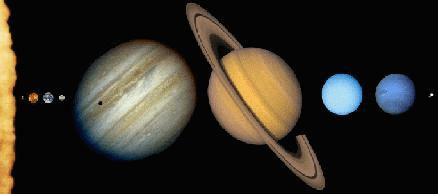|
|

 The
stability and formation of the solar system and other star systems are considered
to be two of the most important unsolved problems of modern physics. In the W-wave
theory we consider that every body in the universe is a W-wave oscillator. In
the case of the sun, this oscillation is indicated by the solar cycle. Usually
people talk about the sunspot cycle instead, but we believe the solar cycle is
a more regular oscillation. In the sunspot cycle sunspots occur by chance and
thus there could be quite a bit of variation in the cycle which might not be characteristic
of the underlying oscillation of the solar cycle. In the process of oscillation
the sun radiates slow moving longitudinal waves from its equator. These waves
travel radially away from the sun through a vacuum gradient (see Dark
Matter on the Cosmology Page) and behave like they are reflected back on themselves.
This behavior (with perhaps other phenomena) produces a set of nodes and antinodes
surrounding the sun (standing wave pattern) extending into space. The spacings
between nodes becomes larger exponentially as the waves move away from the sun
increasing in velocity. The standing wave pattern apparently tends to collect
and hold matter on its nodes. Most of the planets formed at these locations and
are still there today. Some variation occurred when the planets were placed, however,
because of early concentrations of circulating ordinary matter surrounding the
sun. The excess matter tended to change node locations because the excess orbiting
matter slowed down the waves. Also catastrophic events may have displaced the
planets. This modified node locations somewhat so that the planets today do not
fit exactly onto the present node locations. The wave pattern still stabilizes
the system today, however.
The
stability and formation of the solar system and other star systems are considered
to be two of the most important unsolved problems of modern physics. In the W-wave
theory we consider that every body in the universe is a W-wave oscillator. In
the case of the sun, this oscillation is indicated by the solar cycle. Usually
people talk about the sunspot cycle instead, but we believe the solar cycle is
a more regular oscillation. In the sunspot cycle sunspots occur by chance and
thus there could be quite a bit of variation in the cycle which might not be characteristic
of the underlying oscillation of the solar cycle. In the process of oscillation
the sun radiates slow moving longitudinal waves from its equator. These waves
travel radially away from the sun through a vacuum gradient (see Dark
Matter on the Cosmology Page) and behave like they are reflected back on themselves.
This behavior (with perhaps other phenomena) produces a set of nodes and antinodes
surrounding the sun (standing wave pattern) extending into space. The spacings
between nodes becomes larger exponentially as the waves move away from the sun
increasing in velocity. The standing wave pattern apparently tends to collect
and hold matter on its nodes. Most of the planets formed at these locations and
are still there today. Some variation occurred when the planets were placed, however,
because of early concentrations of circulating ordinary matter surrounding the
sun. The excess matter tended to change node locations because the excess orbiting
matter slowed down the waves. Also catastrophic events may have displaced the
planets. This modified node locations somewhat so that the planets today do not
fit exactly onto the present node locations. The wave pattern still stabilizes
the system today, however.
In our previous work W-waves seem to interact with gravity directly and may thus have had or have more influence on matter than is immediately apparent from casual calculations (see article Waves in Dark Matter). Also other unknown characteristics of dark matter and the vacuum may permit much more influence on ordinary matter than is immediately apparent or obvious from our present knowledge of physics. One has to remember that dark matter is not yet well understood. Earlier experiments indicate a difference between vertical and horizontally traveling W-wave velocities here on earth (a larger horizontal velocity). This latter information permits us to hypothesize axially traveling waves moving around the sun. These have a proper velocity such that these waves (in phase with the radial waves) also form a standing wave pattern with nodes in the pattern. A double node is present where one of these nodes overlaps a radially spaced node and provides a location for a planet to form. Note that we have been able to produce standing W-waves in the laboratory in both air and a vacuum.
| Copyright;©1996-2018 Wagner Research Laboratory |